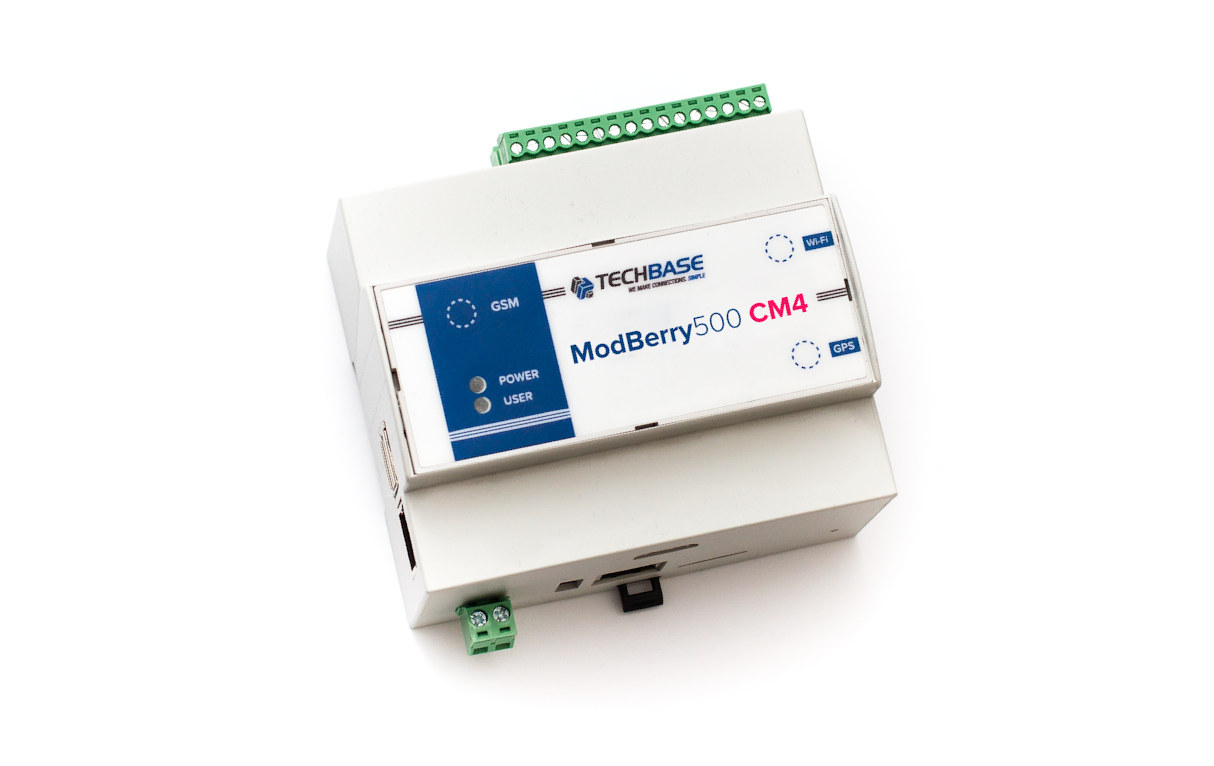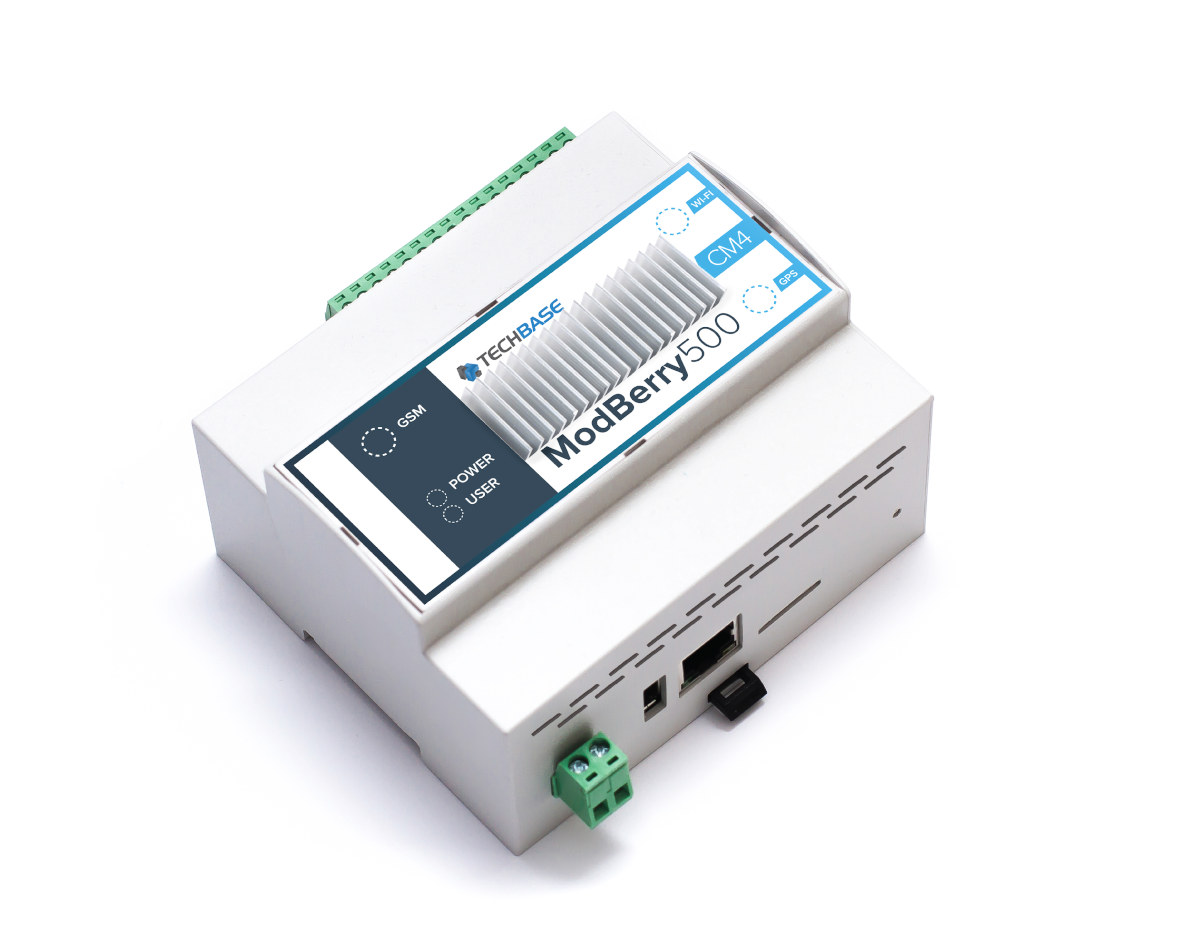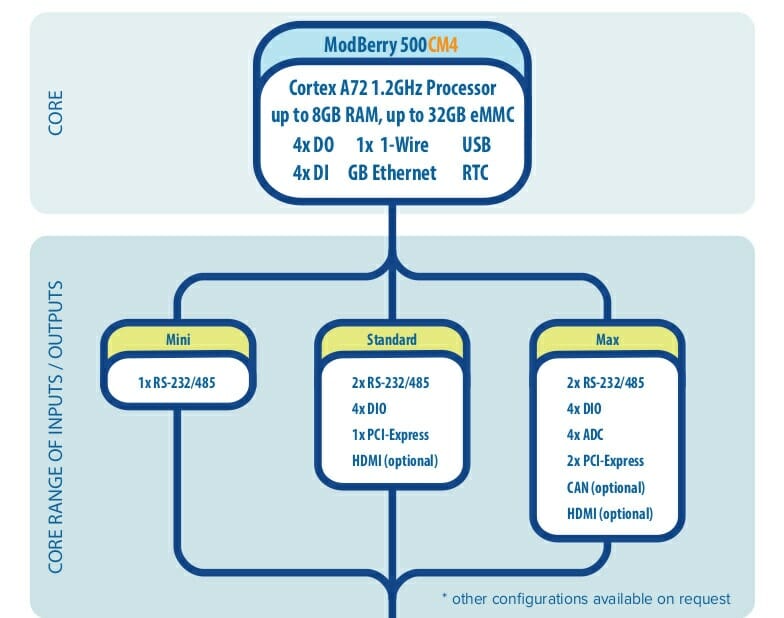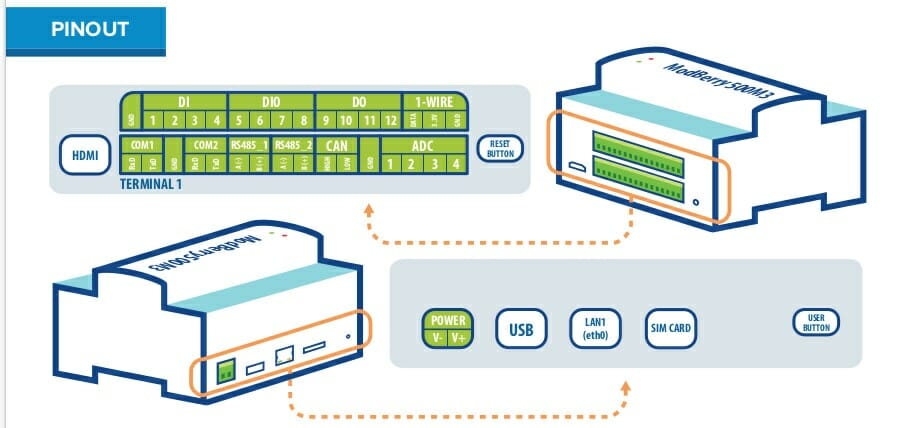We’ve been writing about Techbase Modberry industrial embedded computers with DIN-Rail enclosures such as Modberry M500 or M2000 for several years. Most of their systems are powered by SBC’s like Raspberry Pi 4 or AAEON Up Squared, but they’ve also made models based on Raspberry Pi Compute Module 3+, and with the launch of Raspberry Pi CM4, the company has now introduced Modberry 500 CM4 industrial computer powered by Raspberry Pi Compute Module 4 with up to 8GB RAM and 32GB eMMC flash.
 Modberry 500 CM4 key features and specifications:
Modberry 500 CM4 key features and specifications:
- SoM – Raspberry Pi Compute Module 4 with Broadcom BCM2711 quad-core Cortex-A72 processor @ 1.5 GHz, 1 to 8GB RAM, up to 32GB eMMC flash.
- Storage – Optional NVMe SSD via PCIe 2.0 (mini PCIe or optional M.2 slot)
- Video Output – Optional HDMI port
- Connectivity
- Optional Gigabit Ethernet port
- Optional Wi-Fi (IEEE 802.11 b/g/n/ac) & Bluetooth 5.0
- Optional 5G, 4G/LTE, 3G, or NB-IoT modem plus on-board SIM card socket
- Optional LoRa or WM-Bus
- Optional GPS module
- Optional ZigBee, Z-Wave Ready
- Other ExCard modules
- USB – 1x USB 2.0 host port
- Serial – 2x RS-232 (3 pins) / 2x RS-485 (2 pins)
- I/O expansion ports via 32-pin screw terminal
- 4x Digital inputs (DI) (0..30V DC)
- 4x Digital outputs (DO) (0..30V), max. power efficiency: 500 mA
- 4x Analog inputs – range: 0..10V DC, 18-bit resolution
- 4x configurable DI/DO (0..30V DC), max. power efficiency: 500 mA
- 1x CAN (optional)
- 1x 1-Wire
- Misc – RTC, Watchdog timer, 2x monostable switch button
- Power Supply – 9 ~ 30 V DC (w/o modem: 20W, with modem: 40W) via 2-pin power header
- Dimensions – 106 x 91 x 61 mm (Casing ABS, DIN rail mounting)
- Weight – 350 to 400g depending on options
- Cooling – Passive (internal), active or passive (advanced)
- Temperature Range
- Standard – 0 ~ 55°C, humidity 5 ~ 95% RH (no condensation)
- Extended – -25 ~ 65°C, humidity 5 ~ 95% RH (no condensation)
As you can see from the specifications above, Modberry 500 CM4 is highly configurable, but the company provides three standard models with different I/O configurations namely 500 CM4 “Mini” with a single RS-232/485 port, the “Standard” version with two RS-232/485 ports, four DIO, one (mini) PCIe port, and optional HDMI, as well as a “Max” model adding four ADC, one extra PCIe interface, and optional CAN and/or HDMI.
Techbase provides firmware based on Linux Kernel 4.x, tools & pre-compiled packs including C/C++, JAVA, SQL, PHP, SSH, and VPN support, as well as developer tools and instructions. The system supports remote software updates, and the company’s iMod software platform and iModCloud – cloud computing service for telemetry, remote control and data sharing.
Typical applications for such systems include PLC, telemetry module / data logger, protocol and interface converter, programmable controller, MODBUS gateway, SNMP Agent, cellular router, edge IoT gateway, and more.
Modberry 500 CM4 is available for pre-order now on IIoT Shop for 230 Euros and up. More details may be found on Techbase website.


Jean-Luc started CNX Software in 2010 as a part-time endeavor, before quitting his job as a software engineering manager, and starting to write daily news, and reviews full time later in 2011.
Support CNX Software! Donate via cryptocurrencies, become a Patron on Patreon, or purchase goods on Amazon or Aliexpress







Have you noticed on the first diagram, it lists A72 @ 1.2GHz.
So is the Module 1.2 or 1.5 GHz ??
I hadn’t noticed. It should be 1.5 GHz. I think they forgot to update that part when editing the diagram that was initially made for CM3.
I wondered if heat issues mean they have to under clock.
It should be 1.5GHz. Thank you for pointing that out!
Very interesting how these broadcom SoCs that are not really targeted at industrial applications are now appearing in stuff like this because of the Pi.. You would have thought something from TI or NXP would make more sense.
Even the ordering menu screens at the conveyor sushi places are a screen with a raspberry pi on the back now.
TI doesn’t make anything this simple or affordable, NXP doesn’t make anything this affordable either. That would be why.
Also, no other platform has this much software support.
This reminds me of PIC16F84, a microcontroller released by Microchip in 1993. By 2000-2005, you could find source code and schematics based on PIC16F84 for almost any kind of home automation you could think of. Microchip struggled for years to replace that microcontroller (releasing cheaper and faster microcontrollers, with compatible pin-out). But the software ecosystem was a huge advantage for PIC16F84 versus other solutions from Microchip.
Regarding Modberry 500, I like the “Optional NVMe SSD via […] M.2 slot”.
Reminds me of the Z80